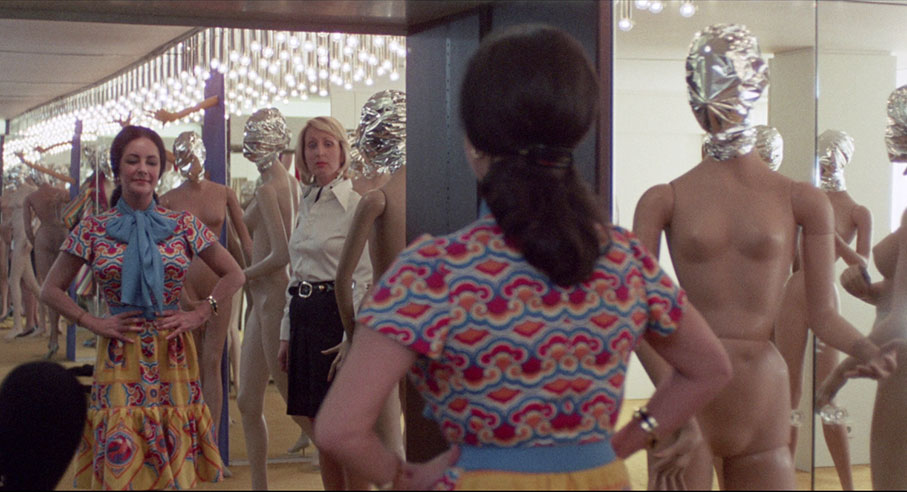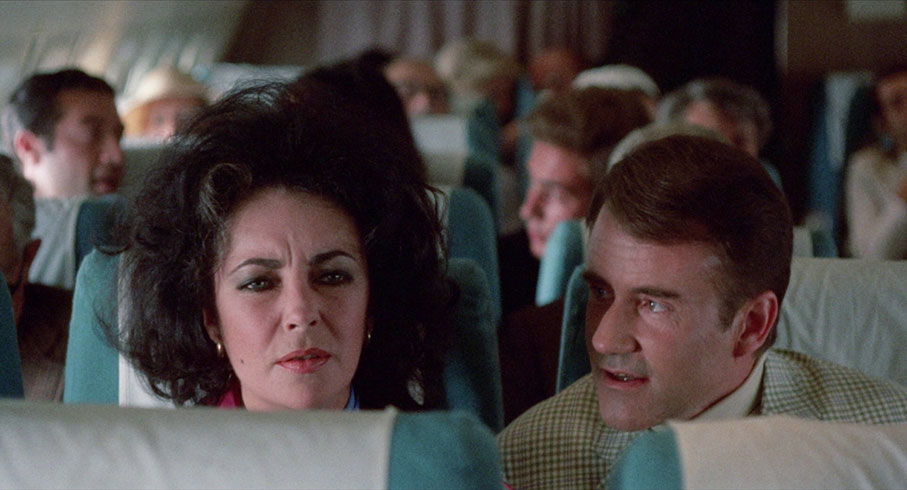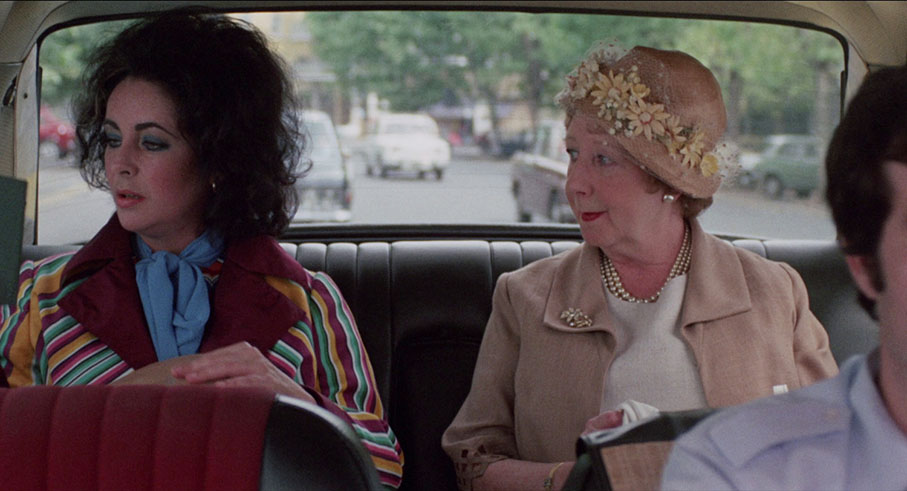|
Lise (Elizabeth Taylor) takes time off work to have a long-awaited holiday in a Southern city. She is there to meet a man, she says. She doesn't know who, but she will know when she sees him that he's her type. But will she, and how will this happen?
First off, a note on the title. The BFI's release privileges the title of The Driver's Seat, which is the title of Muriel Spark's original novella. However, the transfer on this edition has Italian credit sequences for this Italian-made, English-language film and there the title is Identikit. Even the credits from the American version (see below, among the special features) have the title The Driver's Seat but the Identikit title is in brackets underneath. This is certainly understandable, as Identikit was the title of the novella in its Italian translation, and no doubt other languages too, as the expression "to be in the driver's seat" (to be in control) is an English expression which would be meaningless if translated literally. I will be using the title The Driver's Seat to refer to this film during this review. I will also avoid spoilers as much as possible. To make things a little more confusing, the film was released on VHS in the USA under a third title, Psychotic.
The US release of this film on Blu-ray is not for nothing part of a box set called Psychotic Women (released by Severin, which also includes another film previously released by the BFI, Jane Arden's The Other Side of the Underneath). It's a bold role for Elizabeth Taylor to play and it followed some equally off-the-wall roles in the latter part of her career, including Secret Ceremony, directed by Joseph Losey. By now, Taylor was in her mid-forties, a time in many an actress's career when decent roles dry up. Indeed, after playing in the Agatha Christie ensemble piece, The Mirror Crack'd, most of her roles were on television. During the next decade, she spent more time on business ventures and HIV/AIDS activism, the disease having taken the life of her close friend Rock Hudson. The otherwise dreadful The Flintstones gained some mileage in 1994 due to affection for Taylor, appearing in her first American cinema feature for fourteen years, with only Franco Zeffirelli's Young Toscanini, made in Italy in 1988, her only big-screen role in that time. Taylor commands the screen, pretty much onscreen throughout – flashforwards apart, that is, and more about them in a moment.

Muriel Spark (1918-2006) was a Scottish writer, Edinburgh-born. She was a relatively late starter as a writer, partly due to marriage (which ended in separation in 1940) and motherhood (to a son, from whom she later became estranged). Also, there was a war on, and she worked in intelligence through most of it. It wasn't until the war was over that she began to write seriously, beginning with poetry, becoming editor of Poetry Review in 1947. Her first novel, The Comforters, was published in 1957. She published twenty-two novels in total, though "novel" should perhaps go in quotes as most of them are short works, better described as novellas or not much longer than that. The Driver's Seat runs to 100 text pages and is, my estimate, around 25,000 words, making it a novella to my mind. The Public Image was shortlisted for the first ever Booker Prize in 1968 and Loitering with Intent repeated that feat in 1981. Technically, The Driver's Seat was also nominated, though in different circumstances. A change in the Booker eligibility criteria in 1971, from publication in the year before the award to publication in the year of award, meant that novels published in 1970 were never eligible. So, in 2010, there was a retrospective "Lost Booker" shortlist of novels from 1970 still in print and The Driver's Seat was posthumously on it. (The winner was J.G. Farrell, also posthumously, for Troubles.) Spark's work attracted the attention of the film and television industry, most famously her 1961 novel The Prime of Miss Jean Brodie, filmed in 1969 and showcasing an Oscar-winning performance by Maggie Smith and also a 1978 television series starring Geraldine McEwan, which Spark preferred. Elsewhere, The Abbess of Crewe (1974) was filmed in 1977 as Nasty Habits, and Memento Mori (1959) became Jack Clayton's final film as director, made for television under the same title in 1992. There had been interest in The Driver's Seat before the present film was made, at first with Herbert Ross as director from a Frederic Raphael script and later with Luchino Visconti directing and Glenda Jackson starring.
Much has been written about Spark's narrative voice, in particular her use of third-person omniscient, which is on display in The Driver's Seat – present tense, too. Spark converted to Catholicism in 1954 and attributed her ability as a novelist to this: it enabled her to "see human existence as a whole", as a novelist needed to do. So, in The Driver's Seat, we are seeing events from Lise's viewpoint, but from outside it too, which becomes clear early on when the narrative breaks off from a description of her: "Her nose is short and wider than it will look in the likeness constructed partly by the method of identikit, partly by actual photography, soon to be published in the newspapers of four languages."* Present tense is a mode which conventionally eschews any retrospection because the events of the story are happening right now. But this is the first of Spark's many flashforwards, near the start of Chapter 2. At the start of Chapter 3, on page 21 of the edition I'm citing, we know how the story will end, though not yet why. The film is faithful to this structure, though flashforwards weren't then and aren't now especially common in mainstream cinema. They had tended to leak into the mainstream from the French New Wave, some of the films of Alain Resnais in particular. An American example of a film which uses them was They Shoot Horses, Don't They? (1969). Spark seems to have been fond of the device as she also uses it in The Prime of Miss Jean Brodie.
However, if our narrative can see into the future, some details of the present are deliberately withheld. We don't know where Lise comes from, only from "North", though there are hints that it might be Denmark, as Danish is one of the four languages she tells people she speaks. Nor or is it spelled out where she is going on holiday, though the film inevitably places "South" as Italy – Lise arrives on an Alitalia flight, the country's currency is the lira, and the police are carabineri, amongst other things.

Like the novella, the sense that we are in a character's head even if she is ultimately out of reach, gives the film a disturbing edge from the outset, combined with Spark's sometimes cold-blooded way with her characters. In the opening scene of both film and novella, Lise is trying on a dress, best described as it is by another character as "psychedelic", but reacts badly when the saleswoman assures her it's stain-resistant. Does Lise look like she's the kind of woman to spill things on herself? No, she's in control, to a fault. She's in the driver's seat. And she knows exactly why she's going on holiday, even if we don't yet, and who she will meet there. She won't know who he is until she does though, but he will be "her type". Definitely not her type is the man sitting next to her on the flight, Bill (entertainingly played by Ian Bannen), who allows Spark and the film to poke some fun at then-contemporary fads. Bill is an advocate for a macrobiotic diet, mostly based on unpolished rice and the necessity of eating foods classified as yang rather than yin. Oh, and a mandated orgasm a day – is he surprised that Lise won't oblige him there?
The three leading roles in this Italian-made film are all played by anglophone actors, the third being Mona Washbourne as Mrs Fiedke, a woman away from her husband with whom Lise goes shopping and whose nephew may indeed be Lise's type. Also in the cast in a rare acting role is Andy Warhol, a two-scene cameo as an English Lord, with his voice dubbed.
The film is well-directed by Giuseppe Patroni Griffi, who he co-wrote the script with Raffaele La Capria. He was primarily a stage director but had seven screen directing credits to his name. One of those was the 1971 film 'Tis Pity She's a Whore (Addio fratello crudele), starring Charlotte Rampling and Oliver Tobias and based on John Ford's seventeenth-century play. Behind the camera on that film and this was Vittorio Storaro, who by this point had some of his major work with Bernardo Bertolucci (The Conformist, The Spider's Stratagem, Last Tango in Paris) behind him. His work here is more naturalistic than his often is, though making much use of mirrors and glass and other reflective surfaces. Although the film was mainly shot in Rome, studio scenes were filmed in Munich and some exteriors in Hamburg.
The Driver's Seat was released in Italy in 1974 and saw a US release in 1975. For many years, though, it was out of circulation. It never saw a British cinema release, and in fact this Blu-ray is its first commercial release in the UK.
The Driver's Seat is a Blu-ray release from the BFI, a single disc encoded for Region B only. The film has a 15 certificate. The short films don't appear on the BBFC website as I write this, though Darling, Do You Love Me? had an A certificate back in 1968.
The film was shot in 35mm colour and is transferred in its original ratio of 1.85:1, based on a 4K restoration by Cineteca di Bologna and Severin Films, supplied to the BFI by the latter. The results look fine, showcasing Storaro's slightly soft-looking cinematography very well, with grain natural and filmlike. There is occasional print damage in the form of speckles here and there, but nothing too distracting.
The sound is the original mono, rendered as LPCM 1.0. The film very much looks like it was postsynched, as was the case with many Italian films of the period. This results in a slightly hollow-sounding ambience, but clarity is good, and generally there are no issues with lipsynch. English subtitles for the hard-of-hearing are available on the feature only.
Introduction by Kier-La Janisse (5:40)
As with the transfer, some of the extras are carried over from the disc released in the US by Severin, as part of their Psychotic Women box set. This includes this optional introduction to the film. Janisse is the writer of House of Psychotic Women in which The Driver's Seat features and she says the film took a long time to track down and when she saw it she did feel an identification with Lise. This is a hard film to discuss or introduce without too many spoilers, but Janisse manages it.

Commentary by Millie De Chirico
Also carried over from the Severin edition is a commentary by curator/programmer Millie De Chirico. It's not without interest, but there are notable gaps, particularly in the second half, and a little too much description of the on-screen action. There is however some useful information on Muriel Spark and the original novella and Elizabeth Taylor's screen persona and her role here.
A Lack of Absence (22:03)
The title of this featurette comes from the story: Lise will know who the man is she is looking for not from his presence but from a lack of absence. Critic and literary historian takes us through Spark's life and career (her recommendation for Spark neophytes is The Girls of Slender Means) for the first third. We also hear from the woman herself due to extracts from a 1996 BBC documentary, The Elusive Spark – among other things, her superstition about the pens she uses to write her novels, with no one else allowed to touch them, lest they be thrown out. Mayor sees Spark as rather like her writing: precociously bright as a child but not immediately obviously likeable, and not above being cruel to her characters. After this, Mayor analyses the film, illustrated by plentiful clips, and finishes by reading from the novella. Inevitably there are major spoilers afoot, so watch it after the film.
Alternate credit sequences (4:01)
English-language credits from the film's US release, under the title The Driver's Seat, though Identikit is still there as a second title in brackets underneath. Otherwise, they're identical in form to the Italian-language credits on the main feature, black text on a white background.
The remaining extras are curated by the BFI, typically short films from their archive which aren't specific to the main feature but do deal with some of its themes. In this case, three examples of women in the driver's seat or maybe not...
Darling, Do You Love Me? (3:41)
This is an oddity, a brief film in which a woman (Germaine Greer) pursues a hapless man (Alistair Burke). Until the very end, hers is the only dialogue, variations spoken and once sung on the title of the film. It was made in 1968 by Martin Sharp and Bob Whitaker, credited as "a film by" them both. Sharp was an Australian expat who was more often a cartoonist in the satirical magazine Oz and Whitaker was more often a stills photographer whose work was found on Beatles album covers. As well as Sharp and Greer, there's another Australian connection in uncredited editor Colin Eggleston, who would return to his native country at the end of the decade and work in television there and later in cinema, his best film as a director being Long Weekend. Shot in black and white 35mm, the film is presented on this disc in a ratio of 1.37:1 which seems correct, unusual as that is for a 35mm film from this time.
Waiting For… (11:10)
Directed by Anne Basser in 1970, in very grainy sepia-toned black and white 16mm, in which a young woman (Stephanie Turner) is given a camera by a mysterious stranger and tasked to record her everyday reality. It sounds like a more comedic distaff version of Jim McBride's then-recent David Holzman's Diary, but it's as much a nod to the French New Wave and the British documentary tradition (which it gently sends up) as anything else. You can also read it as a comment on how women's voices are less often heard than men's on screen. The transfer is a little beat-up at the start, with scratches and speckles and a noticeable hiss on the soundtrack, but it does settle down after that.
The Telephone (3:35)
A young woman (Cathryn Harrison) takes her revenge on her boyfriend for playing away, and the device of the title plays a part in it. In fact, there is no title card on this film, or credits of any kind. It was directed by Christopher Petit in 1981, after Radio On, and was shot in Super 16mm by Curtis Clark, partly as a test of the gauge before Clark shot The Draughtsman's Contract on the same film stock.

The Driver's Seat stage production trailer (1:41)
In 2015, the National Theatre of Scotland put on a stage adaptation of The Driver's Seat, directed by Laurie Sansom. This is a trailer for that production.
Booklet
The BFI's booklet, available in the first pressing only, runs to thirty-two pages. It has a prominent (and deserved) spoiler warning but actually begins with a reproduction of Elizabeth Taylor's letter to Muriel Spark replying to the latter's enthusiasm at Taylor playing Lise. The letter is typewritten but is signed by hand as "Elizabeth Taylor Burton", although by the time the film was in production, Taylor's marriage to Richard Burton was over, though they remarried in 1975 only to divorce again the following year.
The first essay is by Simon McCallum, who gives us an overview of the film, its making and its place in Taylor's career. He covers its premiere in 1974 (in Monte Carlo, with Taylor, Warhol and Salvador Dalí in attendance) and the rather mixed reaction the film had. There were however positive reviews (The Hollywood Reporter said it was "quite possibly one of the best films Elizabeth Taylor has ever appeared in), and the story that Taylor was so displeased by the film that she tried to suppress it appears to be incorrect.
Next up are reproductions of Taylor's handwritten notes on a rough-cut screening of The Driver's Seat, on Richard Brooks's memo pad as she presumably watched it with him. (Ian Bannen may also have been present as he was making Bite the Bullet for Brooks at that time.) This is followed by an essay on the film by Bruce LaBruce, who first saw the film in a VHS rip in the 1980s and likes it more than he did then. He sees the film as an allegory for modern alienation in the face of violence and terrorism (with that occurring in the background of the story), plus more than a little camp, as well as the police procedural enabled by the flashforwards.
After the full film credits is a reprint of Kier-La Janisse's short essay on the film from House of Psychotic Women, notes on and credits for the extras, plus several stills, some of them from the Elizabeth Taylor Archive.
For many years, The Driver's Seat was an almost-lost film in Elizabeth Taylor's filmography, unavailable for many years other than as bootleg videotape rips. Now restored, it boasts one of Taylor's boldest performances in a faithful adaptation of Muriel Spark's novella. The BFI's Blu-ray marks the film's first commercial release in the UK and gives a good account of the film, with some intriguing extras.
|